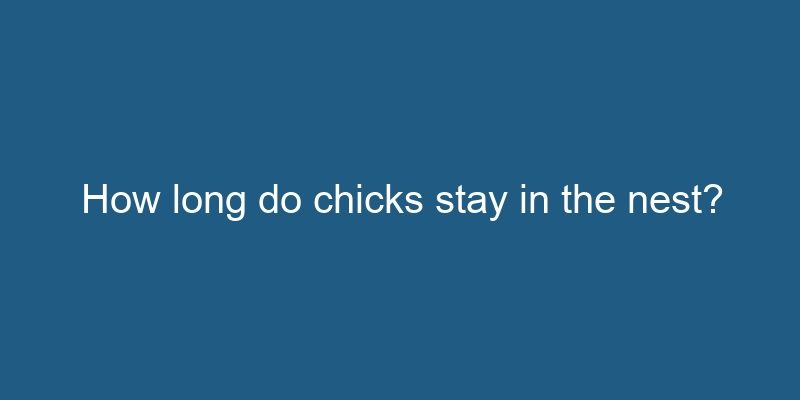When it comes to the duration of time that chicks stay in the nest, it varies depending on the species of birds. Different birds have different developmental stages and behaviors, which directly influence the amount of time they spend in the nest before they are ready to leave. In this article, we will explore the typical duration chicks spend in the nest for various bird species.
- 1. Albatross
- 2. Bald Eagle
- 3. Blue Jay
- 4. Penguin
- 5. Sparrow
- 6. Flamingo
- 7. Robin
- 8. Owl
- 9. Woodpecker
- 10. Swallow
- 11. Seagull
- Frequently Asked Questions (FAQs)
- How do birds know when it’s time to leave the nest?
- What happens if a chick leaves the nest too early?
- Do all bird species build nests?
- Why do some birds have longer nest stay periods than others?
- Can chicks fly immediately after leaving the nest?
- What are the risks faced by chicks after leaving the nest?
- Do all chicks receive equal care from their parents?
- Do chicks return to the nest after leaving?
- What are the benefits of staying in the nest for an extended period?
- How do chicks learn to fly?
- Conclusion
1. Albatross
Albatross chicks have one of the longest nest stays. These majestic seabirds have a fascinating breeding cycle. After laying a single egg, both the male and female albatross take turns incubating the egg for about two months. Once the chick hatches, it will spend an astonishingly long time in the nest. Albatross chicks remain in the nest for approximately 5 to 7 months, during which they are fed and cared for by their parents. This extensive period allows the chicks to develop their flight feathers and gain strength before taking their first flight.
2. Bald Eagle
The iconic Bald Eagle, a symbol of strength and freedom, also has a relatively long nest stay for its chicks. After hatching from an egg, the young eagles, known as eaglets, stay in the nest for around 10 to 12 weeks. During this time, both parents actively provide food and protection. The eaglets grow rapidly, developing their feathers and gaining strength. Once they are capable of flight, they leave the nest and begin their own independent journeys.
3. Blue Jay
Blue Jays, known for their vibrant blue feathers and distinctive calls, have a relatively short nest stay period. After the eggs hatch, the chicks spend around 17 to 21 days in the nest. During this time, the parent birds diligently feed and care for their young ones. Once the chicks have grown enough feathers and are able to fly, they leave the nest and begin exploring the surrounding environment.
4. Penguin
Penguins, the adorable and charismatic birds of the southern hemisphere, have a unique nesting and chick-rearing behavior. When a penguin chick hatches, it is generally covered in down feathers and requires warmth and protection. The chick remains in the nest, often called a creche, for approximately 2 to 3 months. During this time, the parents take turns foraging for food and returning to feed the chick. Once the chick has grown enough feathers to withstand the cold waters, it is ready to join the rest of the colony and learn the ways of survival in the harsh Antarctic environment.
5. Sparrow
Sparrows, small and agile birds found in various habitats, have a relatively short nesting period. Once the eggs hatch, the chicks remain in the nest for about 10 to 14 days. During this time, the parent sparrows diligently provide food to their offspring. As the chicks grow feathers and become more active, they leave the nest and start exploring their surroundings.
6. Flamingo
Flamingos, with their vibrant pink plumage and unique appearance, have intriguing nesting habits. After hatching, flamingo chicks stay in the nest, called a crèche, for around 5 to 12 days. During this time, both parents take turns feeding and caring for the chicks. Once the chicks have gained enough strength and coordination, they leave the nest and join larger groups of flamingos called colonies. These colonies provide safety and support as the young flamingos continue to grow and develop.
7. Robin
Robins, popular songbirds known for their melodious tunes, have a relatively short nest stay for their chicks. Once the eggs hatch, the chicks spend approximately 12 to 16 days in the nest. During this time, the parent robins tirelessly provide food and care. As the chicks grow feathers and become more active, they leave the nest and embark on their own journeys.
8. Owl
Owls, renowned for their nocturnal habits and silent flight, have a longer nest stay compared to some other bird species. Once the owl chicks hatch, they remain in the nest for about 6 to 9 weeks. During this time, the parent owls provide nourishment and protection. As the chicks develop their flight feathers and gain strength, they leave the nest and start exploring their surroundings under the guidance of their parents.
9. Woodpecker
Woodpeckers, known for their distinctive drumming sounds and ability to excavate tree trunks, have a relatively short nest stay for their chicks. Once the eggs hatch, the chicks spend around 18 to 21 days in the nest. During this time, both parent woodpeckers actively provide food and care. As the chicks grow feathers and become more independent, they leave the nest and begin their own woodpecker journeys.
10. Swallow
Swallows, agile and graceful birds often seen swooping through the air, have a relatively short nest stay period. Once the eggs hatch, the chicks spend around 15 to 24 days in the nest. During this time, the parent swallows tirelessly provide food and care. As the chicks grow feathers and become more adept at flying, they leave the nest and join the swift and acrobatic world of swallows in the skies.
11. Seagull
Seagulls, commonly found near coastlines and bodies of water, have a relatively long nest stay for their chicks. After hatching, seagull chicks stay in the nest for approximately 25 to 35 days. During this time, both parents actively provide food and protection. As the chicks develop their flight capabilities and gain strength, they leave the nest and venture into the world of seagulls along shorelines and oceans.
Frequently Asked Questions (FAQs)
-
How do birds know when it’s time to leave the nest?
Birds have innate instincts and cues that help them determine when it’s time to leave the nest. These cues include the development of flight feathers, increased strength and coordination, and the encouragement from their parents to venture out into the world. Additionally, environmental factors such as food availability and changing seasons also play a role in signaling the appropriate time to leave the nest.
-
What happens if a chick leaves the nest too early?
If a chick leaves the nest before it is fully developed and capable of flight, it may face numerous challenges and risks. These include vulnerability to predators, difficulty finding food, exposure to harsh weather conditions, and limited chances of survival. It is crucial for chicks to stay in the nest until they are ready for independent living to ensure their best chances of survival.
-
Do all bird species build nests?
No, not all bird species build nests. Some birds, like penguins, flamingos, and seagulls, create nest-like structures or colonies rather than traditional nests. These birds rely on communal breeding grounds or structures to raise their young. However, the majority of bird species do build nests to provide a safe and secure environment for their eggs and chicks.
-
Why do some birds have longer nest stay periods than others?
The duration of nest stay varies among bird species due to their unique evolutionary adaptations and ecological requirements. Birds with longer nest stays often have more complex developmental needs, such as growing flight feathers, learning essential survival skills, and acquiring strength and coordination. These species require a longer period of parental care and protection before they are ready to leave the nest.
-
Can chicks fly immediately after leaving the nest?
No, chicks cannot fly immediately after leaving the nest. They need to develop their flight feathers, gain strength, and practice flying before they can become proficient at flying. After leaving the nest, young birds undergo a period of learning and honing their flying skills, gradually becoming independent flyers.
-
What are the risks faced by chicks after leaving the nest?
After leaving the nest, chicks face various risks and challenges. These include predation from other animals, exposure to harsh weather conditions, competition for food and territory, and the need to navigate unfamiliar environments. The transition from the nest to independent living can be a critical phase for young birds, and their survival depends on their ability to adapt and overcome these challenges.
-
Do all chicks receive equal care from their parents?
While most bird species provide care and attention to all their chicks, there can be variations in the level of care among individuals or within a species. Factors such as the availability of food, the health of the parents, and the number of offspring can influence the extent of care provided. In some cases, the strongest or most dominant chicks may receive more attention and resources from their parents.
-
Do chicks return to the nest after leaving?
Once chicks leave the nest, they typically do not return. However, some bird species may return to the nest site for roosting or breeding purposes in subsequent years. However, this behavior varies among species, and the majority of birds establish new territories and build new nests for future breeding cycles.
-
What are the benefits of staying in the nest for an extended period?
Staying in the nest for an extended period allows chicks to develop essential skills and physical attributes required for survival. This includes the growth of flight feathers, muscle development, learning from parental guidance, and acquiring necessary social interactions with siblings. The extended nest stay ensures that the chicks are well-prepared for the challenges they will face once they leave the nest.
-
How do chicks learn to fly?
Chicks learn to fly through a combination of innate instincts and observational learning from their parents. As the chicks grow older and gain strength, they begin to exercise their wings, flapping them vigorously to strengthen their flight muscles. The parents may also demonstrate flying techniques and guide the chicks during their first flights. Through practice and trial-and-error, the chicks gradually develop their flying skills.
Conclusion
The duration chicks spend in the nest varies greatly among bird species. Factors such as developmental needs, evolutionary adaptations, and ecological requirements influence the length of the nest stay. Some birds, like albatrosses and penguins, have remarkably long nest stays to ensure their chicks are well-prepared for survival in their respective environments. On the other hand, birds like sparrows and swallows have relatively short nest stays, allowing their chicks to quickly develop the necessary skills for independence. The nest stay period is a critical phase in a bird’s life, providing opportunities for growth, learning, and social interactions before embarking on their own journeys in the world of flight.










